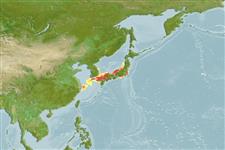Environment: milieu / climate zone / depth range / distribution range
Ecologia
marino demersale. Temperate
Northwest Pacific: Japan Sea off coast of northern Honshu, Japan.
Size / Peso / Age
Maturity: Lm ? range ? - ? cm
Short description
Chiavi di identificazione | Morfologia | Morfometria
Spine dorsali (totale) : 11 - 13; Raggi dorsali molli (totale) : 9 - 10; Spine anali: 0; Raggi anali molli: 17 - 20. Closely resembles O. iburia in general appearance, but differs by having a few enlarged subpectoral plates, and 35 or fewer dorsolateral and ventrolateral plates.
Life cycle and mating behavior
Maturities | Riproduzione | Spawnings | Egg(s) | Fecundities | Larve
Masuda, H., K. Amaoka, C. Araga, T. Uyeno and T. Yoshino, 1984. The fishes of the Japanese Archipelago. Vol. 1. Tokai University Press, Tokyo, Japan. 437 p. (text). (Ref. 559)
IUCN Red List Status (Ref. 130435)
Threat to humans
Harmless
Human uses
Strumenti
Special reports
Download XML
Fonti Internet
Estimates based on models
Phylogenetic diversity index (Ref.
82804): PD
50 = 0.5625 [Uniqueness, from 0.5 = low to 2.0 = high].
Bayesian length-weight: a=0.00389 (0.00180 - 0.00842), b=3.12 (2.94 - 3.30), in cm total length, based on all LWR estimates for this body shape (Ref.
93245).
Trophic level (Ref.
69278): 3.2 ±0.3 se; based on size and trophs of closest relatives
Resilienza (Ref.
120179): Medio, tempo minimo di raddoppiamento della popolazione 1.4 - 4.4 anni (Preliminary K or Fecundity.).
Fishing Vulnerability (Ref.
59153): Low vulnerability (16 of 100).
